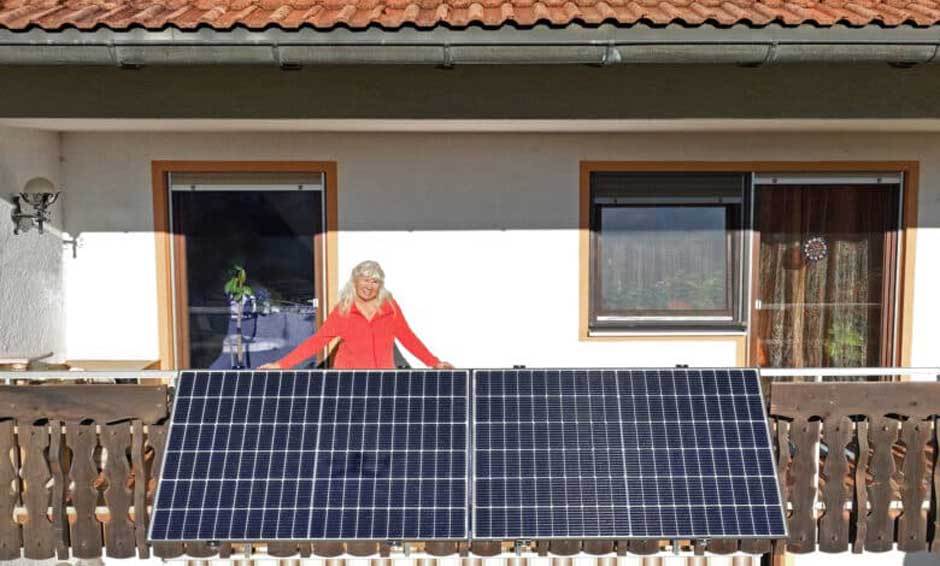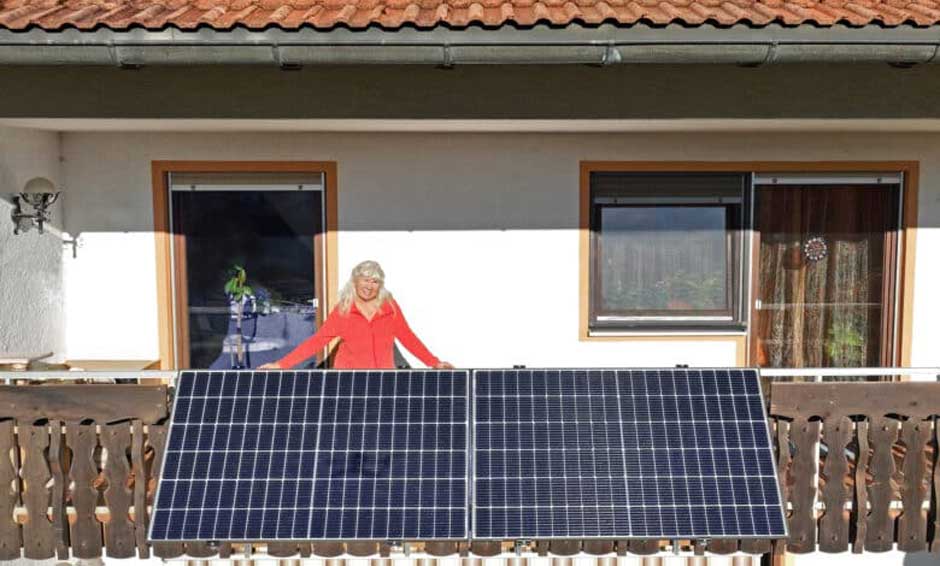A balcony power plant is a small photovoltaic system installed on the balcony or terrace. The balcony solar system comprises one or two solar modules, an inverter, and the necessary connections. As a rule, balcony PV systems are used for self-consumption, i.e., no electricity is fed into the grid.

For a long time, the installation of balcony power plants represented a legal gray area. Photovoltaic systems (PV systems) for balconies have only been expressly permitted since the end of 2018 following the installation standard VDE 0100-551-1. This means tenants or apartment owners without roofs can now generate environmentally friendly and inexpensive solar power from their balconies or terrace. We show the advantages of a balcony solar powered generator and what needs to be considered when choosing and operating it.
What is a balcony power plant?
A balcony power plant is a small photovoltaic system mounted on a balcony or erected on a terrace. Therefore, compact solar systems are called “balcony PV systems” or “mini PV systems.”
A PV system for the balcony usually consists of one or two complete solar power kits for homes, a power inverter, and the necessary cables and connections. In principle, it works like a large PV system, but due to its size, it only has a comparatively low output.

How does a PV system for the balcony work, and what are the benefits?
The solar modules of a mini PV system are placed on the balcony, either with the help of special brackets on the balcony wall or the parapet or on stands on the ground. Like any other photovoltaic system, the photovoltaic balcony modules convert solar energy into direct current. For ordinary electronic devices to be able to use them, they must first be converted into alternating currents. A power inverter takes over this task. This is also used to feed solar power into the home network.
The inverter is connected to a socket. The electricity generated by the balcony power plant can be used directly for self-consumption. If additional electricity is required in the household, it is obtained from the electricity provider as usual.
The maximum output of a photovoltaic system for the balcony is currently between 300 and 600 W. According to the Association of Electrical, Electronic & Information Technologies standard, e. V. (VDE), 600 W, also represents the maximum permissible power that can be fed into the grid. At 230 V, 600 W corresponds to an additional 2.6 amps. Modern domestic installations are protected with 16 A, and the lines are designed for 20 A.
Therefore, the balcony power plant’s feed-in power is small enough that it does not pose a danger to the circuit in a typical house. For example, house fires resulting from the feed-in can be ruled out. The limitation to 600 W is occasionally criticized because current installations can also handle higher feed-in capacities without any problems. In Austria, for example, the limit is 880 W.
Regardless of how practical the maximum value is – it must not be exceeded, not even if several balcony power plants are feeding solar power into the home power grid in parallel. There is another risk here: If the grid fails, the inverters no longer recognize this if the other PV system continues to supply electricity and do not switch off. However, this is necessary to carry out repairs, for example.
The great strengths of small photovoltaic balcony systems
If you live for rent or cannot use the roof of your house for a solar power system for other reasons, you can actively contribute to the energy transition thanks to a balcony power plant. On the other hand, the total costs for the generation of solar power, even for balcony power plants, are below the electricity prices of the electricity providers. Although the level of production costs is generally difficult to estimate, it can be said in principle: even if a balcony power plant delivers a lower yield than a large PV system, it will pay for itself after a few years.
Suppose the system delivers 400 kWh of electricity per year under less-than-ideal conditions, of which 300 kWh is consumed. In that case, this results in savings of 90 to 150 €, depending on the current mains electricity price (30 – 50 cents / kWh). The acquisition costs are in the three-digit to the low four-digit range. This means the investment paid for itself in 10 years or less. With a service life of 20 – 30 years, free solar power can then be used for 10 years or more.
Compared to roof photovoltaic systems, balcony PV systems are characterized by extremely simple installation. Appropriate elevations or attachments for balcony walls or parapets are either supplied or can be purchased separately.
Photovoltaics on the balcony: standard-compliant use
Balcony PV systems that feed electricity into the home network must comply with the VDE standard (Application Guide VDE-AR-N 4105). An electrician should carry out the installation. Commissioning by a qualified electrician is no longer mandatory by law.
When considering the legal situation regarding the standard for balcony power plants, it should be noted that the question has not yet been conclusively answered as to whether an ordinary protective contact socket (Schuko) with the associated plug on the PV balcony system is sufficient for the connection. The VDE, for example, denies this. Other experts see no problem.
There is a lot to be said for the Schuko socket if the inverter used in the PV system meets the relevant inverter standard, i.e., if it has what is known as NA protection. This ensures that the inverter “switches on” the system as soon as the plug has been pulled and the Schuko contacts are de-energized. You are safe using a so-called Wieland plug with the associated socket to feed in the solar power from your balcony PV system.
A Wieland power socket has to be installed by an electrician, which entails costs of €150 to €200 and thus extends the amortization period of the system. Unlike Schuko plugs, Wieland plugs do not have protruding metal pins that one could accidentally come into contact with, while the balcony photovoltaic system generates electricity. However, the standard-compliant inverter switches off in fractions of a second when disconnected from the grid, so there is no risk of an electric shock, even with a Schuko plug.
Do you have to register a balcony power plant?
The operator of a balcony PV system is obliged to register it in the market master data register of the Federal Network Agency. Without such a fee-free registration, a balcony power plant operation is not permitted. Anyone who operates a balcony power plant without registering is committing an administrative offense that can result in a fine.
There is an EU regulation in which power generation systems are only considered “significant” from an output of 800 W, which means that a PV balcony system limited to a maximum of 600 W would not be subject to the relevant provisions. However, this regulation has not yet been implemented in Germany. Thus, a balcony power plant is currently to be registered in the same way as an ordinary PV system. Otherwise, the same rights and obligations apply.
The only difference: Since a PV balcony system is usually only used for self-sufficiency and does not reach an output of 1 kW, it is permitted to operate the balcony power plant without complying with the annual, relatively complex notification obligation to the Federal Network Agency. This represents a significant relief and makes using a balcony power plant comparatively unbureaucratic. On the other hand, those who do not use a mini-PV system for their consumption but primarily want to receive the feed-in tariff for solar power do not benefit from this special regulation.
Speaking of feed-in tariffs: It also makes economic sense for balcony power plants to use as much self-generated solar power as possible. Since the system’s performance is not too high, this should generally be the case because every household has a base load, i.e., continuous, relatively constant power consumption. Surpluses that are fed in are, therefore, small. Many operators of the mini solar systems, therefore, forego the feed-in tariff, as this would also have to be taken into account as income for tax purposes.
Every operator can register his balcony power plant himself. As with large PV systems, this is a two-stage process, with personal registration first. In the second step, the mini solar system is reported. An authorized person can also carry out this task – for example, an electrician.
Registration with the network operator is also required. This often requires the retrofitting of a feed-in or bi-directional meter. There is always a dispute about who will bear the cost of installation. It is undisputed that the meter costs an annual rent even then.
Caution is advised if an analog electricity meter is still available: it runs backward if a PV balcony system produces more electricity than is currently used in the household. Technically this is not a problem, but legally not permissible. System owners need at least one meter with a so-called backstop. There is a risk that the metering point operator will report it. This problem does not exist with current smart meters.
Is there a subsidy for balcony power plants?
A nationwide promotion of the mini solar systems is not yet in sight. However, individual municipalities and regional associations have already begun to subsidize plug-in solar devices. If you want to know more about this, you can only ask your municipality or supplier now.
Schleswig-Holstein has adapted its “Climate Protection for Citizens” program. Since January 2023, balcony PV systems up to 600 W have been subsidized with up to €200.
The citizens of Mecklenburg-Western Pomerania have it better: The federal state supports purchasing and installing the balcony PV system with a maximum fixed amount of 500 € per plug-in PV system and apartment unit. The funding can be applied for since November 2022 via the state funding institute.
And since February 2023, balcony systems have also been subsidized in Berlin with 500 euros per project. The funding, for which 7 million euros have been set aside, can then be applied for online at the Investitionsbank Berlin (IBB) via the “SolarPLUS” program.
In addition to the federal states, municipalities also provide funds to promote balcony power plants.
Is a balcony power plant with storage worthwhile?
Power storage for solar systems opens up the possibility of using generated solar power later. A balcony solar system with storage increases your consumption, you are less dependent on external electricity supply, and the electricity costs are lower. However, the excess generated by a balcony power plant is very small. Investing in storage is generally not worthwhile if only excess solar power is to be stored.
What should be considered when buying a photovoltaic system for the balcony?
The following aspects make it easier for interested parties to select a specific balcony power plant:
- The inverter must have NA protection.
- The performance of the solar panels should only slightly exceed the maximum possible performance of the inverter.
- The inverter must be regulated if the solar modules deliver more than 600 W maximum power.
- Common solar modules belong to the protection class IP6x. This means they are dustproof and waterproof to the touch. Depending on which number is in place of the “x,” they either only have “protection against splash water” (IP64) or “protection against powerful jets of water” (IP66). If the system is exposed to severe weather, choosing a device with a higher protection class is better.
- The service life of a PV system ultimately determines its profitability. Interested parties should therefore check the manufacturers’ service life and warranty periods for their products before making a purchase.

